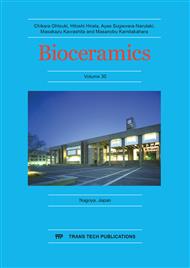[1]
S.M. Kurtz, J.N. Devine, PEEK biomaterials in trauma, orthopedic, and spinal implants, Biomaterials 28 (2007) 4845-4869.
DOI: 10.1016/j.biomaterials.2007.07.013
Google Scholar
[2]
T. Shimizu, S. Fujibayashi, S. Yamaguchi, K. Yamamoto, B. Otsuki, M. Takemoto, M. Tsukanaka, T. Kizuki, T. Matsushita, T. Kokubo, S. Matsuda, Bioactivity of sol-gel-derived TiO2 coating on polyetheretherketone: In vitro and in vivo studies, Acta Biomater. 35 (2016).
DOI: 10.1016/j.actbio.2016.02.007
Google Scholar
[3]
T. Kokubo, H. Takadama, How useful is SBF in predicting in vivo bone bioactivity?, Biomaterials 27 (2006) 2907-2915.
DOI: 10.1016/j.biomaterials.2006.01.017
Google Scholar
[4]
ISO 23317: 2007, Implants for surgery - In vitro evaluation for apatite-forming ability of implant materials.
Google Scholar
[5]
T. Yao, M. Hibino, S. Yamaguchi, H. Okada, U.S. Patent 8,178,066. (2013), Japanese Patent 5,261,712. (2012).
Google Scholar
[6]
T. Yao, M. Hibino, T. Yabutsuka, U.S. Patent 8,512,732. (2013), Japanese Patent 5,252,399. (2013).
Google Scholar
[7]
T. Yabutsuka, K. Fukushima, T. Hiruta, S. Takai, T. Yao, Effect of pores formation process and oxygen plasma treatment to hydroxyapatite formation on bioactive PEEK prepared by incorporation of precursor of apatite, Mater. Sci. Eng. C 81 (2017).
DOI: 10.1016/j.msec.2017.07.017
Google Scholar
[8]
T. Yabutsuka, K. Fukushima, T. Hiruta, S. Takai, T. Yao, Fabrication of bioactive fiber-reinforced PEEK and MXD6 by incorporation of precursor of apatite, J. Biomed. Mater. Res. B: Appl. Biomater. in press.
DOI: 10.1002/jbm.b.34025
Google Scholar
[9]
T.W.G. Solomons, C.B. Fryhle, Organic Chemistry, seventh ed., Wiley, New York, (2000).
Google Scholar
[10]
M. Tanahashi, T. Yao, T. Kokubo, M. Minoda, T. Miyamoto, T. Nakamura, T. Yamamuro, Apatite coated on organic polymers by biomimetic process: Improvement in its adhesion to substrate by glow-discharge treatment, J. Biomed. Mater. Res. 29 (1995).
DOI: 10.1002/jbm.820290310
Google Scholar
[11]
T. Miyazaki, C. Matsunami, Y. Shirosaki, Bioactive carbon-PEEK composites prepared by chemical surface treatment, Mater. Sci. Eng. C 70 (2017) 71-75.
DOI: 10.1016/j.msec.2016.08.058
Google Scholar


